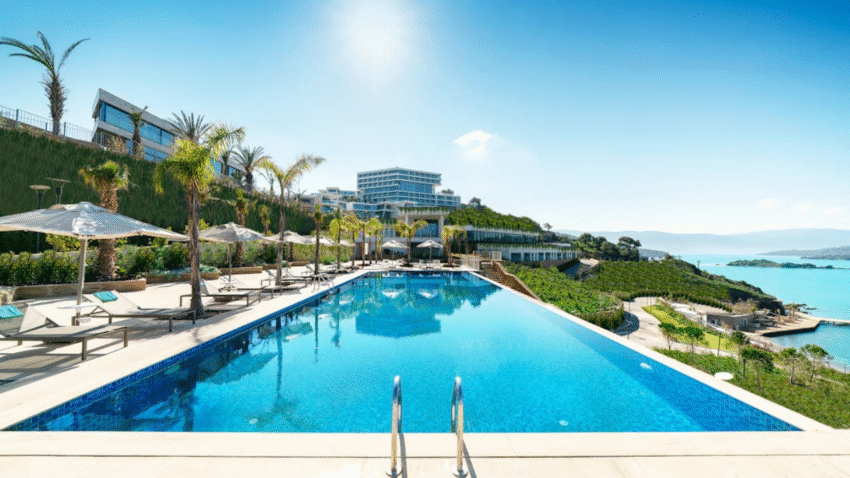Introduction
Struggling to maintain chlorine levels in your outdoor pool? You might be missing a key ingredient—pool stabilizer. In this step-by-step guide, you’ll learn how to use pool stabilizer correctly to protect your chlorine from sunlight, reduce chemical costs, and keep your pool water crystal clear. If your chlorine keeps disappearing, this simple product might be the solution.
Why Pool Stabilizer Matters
Pool stabilizer, also known as cyanuric acid (CYA), plays a crucial role in outdoor pool maintenance. Sunlight breaks down chlorine quickly, and without stabilizer, up to 90% of your free chlorine can vanish within two hours on a sunny day. Stabilizer slows this process, allowing chlorine to stay active longer.
Proper use of stabilizer helps:
- Extend chlorine lifespan
- Reduce how often you add chlorine
- Improve sanitation and algae prevention
- Maintain consistent water chemistry
But too much stabilizer can reduce chlorine effectiveness, so it’s vital to use it in the right amount.
Step-by-Step Guide to Using Pool Stabilizer
Step 1: Test Your Stabilizer Level
Before adding any stabilizer, test your pool water to determine the current CYA level. Use a test strip or a liquid reagent kit specifically designed to measure cyanuric acid.
- Ideal CYA level:
- Outdoor chlorine pools: 30–50 ppm
- Saltwater pools: 60–80 ppm
- Indoor pools: No stabilizer needed
Tip: If your level is already high (above 100 ppm), you may need to partially drain and refill your pool instead of adding more.
Step 2: Choose the Right Type of Stabilizer
There are two main types of stabilizer products:
- Granular Cyanuric Acid: Most common and budget-friendly.
- Liquid Stabilizer: Dissolves quickly and easier to apply but typically costs more.
Most pool owners use granular stabilizer unless they’re in a rush or need a fast-dissolving product.
Step 3: Calculate the Correct Amount
Adding too much stabilizer can “lock” your chlorine and make it ineffective, so always measure carefully. A common rule of thumb is:
- 1 lb of stabilizer raises CYA by 10 ppm per 10,000 gallons of water
Use this formula to calculate the amount needed:
pgsqlCopyEditAmount to add (lbs) = (Target CYA - Current CYA) × (Pool gallons ÷ 10,000) ÷ 10
Example: If your 20,000-gallon pool has 20 ppm and you want 40 ppm:
(40 – 20) × (20,000 ÷ 10,000) ÷ 10 = 2 × 2 = 4 lbs of stabilizer
Step 4: Add Stabilizer to the Pool
Never pour dry stabilizer directly into your pool—it can stain liners or settle on surfaces. Instead, use one of the following methods:
Option 1: Skimmer Sock (Preferred Method)
- Place stabilizer in a skimmer sock or old pantyhose.
- Tie the sock and place it inside the skimmer basket.
- Let water flow over it while the pump is running.
- Gently squeeze the sock occasionally to speed up dissolving.
Option 2: Dilution in a Bucket (For Concrete Pools Only)
- Fill a 5-gallon bucket with warm water.
- Add the stabilizer slowly, stirring to dissolve.
- Pour the solution slowly into the pool near return jets.
⚠️ Caution: Only use the bucket method for plaster/concrete pools. Avoid it in vinyl or fiberglass pools due to potential damage.
Step 5: Run the Pump and Let It Circulate
Keep your pump running for 24 hours to ensure even distribution. Avoid swimming for at least 4–6 hours after adding stabilizer.
Note: It may take 24–48 hours for stabilizer to fully register on a test strip or kit, so don’t rush to re-test immediately.
Step 6: Retest and Monitor
After 2–3 days, retest your CYA level to ensure it has reached the desired range. If it’s still too low, you can add more using the same process.
Tip: Stabilizer does not evaporate. The only way it leaves the pool is through backwashing, splash-out, leaks, or draining.
Common Mistakes to Avoid
- Adding Stabilizer Directly to the Pool
- Can lead to cloudy water or permanent staining.
- Solution: Use a skimmer sock or pre-dissolve in a bucket (for concrete pools).
- Overdosing on Stabilizer
- High CYA levels can prevent chlorine from working properly.
- Solution: Test levels first and calculate dosage carefully.
- Mixing with Other Chemicals
- Adding stabilizer at the same time as chlorine or acid can create reactions.
- Solution: Add stabilizer on its own and allow circulation time before adding other chemicals.
- Skipping the Circulation Step
- Inadequate mixing can cause uneven CYA levels or buildup.
- Solution: Run the pump for at least 24 hours after adding stabilizer.
- Using Stabilizer in Indoor Pools
- Stabilizer isn’t needed indoors since UV light isn’t a factor.
- Solution: Don’t use CYA in covered or indoor pools.
Extra Tips & Pool Hacks
- Use Dichlor or Trichlor Tablets for Built-in Stabilizer: These chlorine products already contain CYA. Use them with caution if your levels are high.
- Check CYA Monthly in Summer: Stabilizer doesn’t degrade but can accumulate—monitor regularly to avoid over-stabilization.
- Drain & Refill to Lower CYA: If your level is over 100 ppm, the only fix is dilution through draining and refilling part of your pool.
🧪 Want to keep your chlorine effective all summer? Read our guide on how to shock your pool properly to complete your water care routine.
Conclusion
Using pool stabilizer correctly is one of the easiest ways to protect your chlorine, save money on chemicals, and keep your pool sparkling all season. Just remember to test before adding, calculate your dosage carefully, and follow safe application methods. A little stabilizer goes a long way—so use it wisely and enjoy worry-free swimming.
💡 Final Tip: Bookmark this guide for pool season so you never second-guess your stabilizer routine again!
